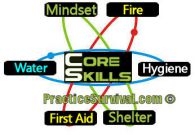The minimum amount of water necessary to sustain one human for 24 hours is 2 gallons. According to the USA EPA an average family uses nearly 400 gallons of water each day. Let’s get real though, you just got rousted from your domicile you are excited, high heart rate, high stress, heavy lifting, carrying, exertion beyond most people’s monthly activity level in one day, you are going to burn off, sweat off and use way more than these minimums.
The US EPA had identified that there are 34 elements that impair water sources.
Water Contamination
Non-Biological
Your water supplier if you have not received a copy of the CCR for your water supply system.
If you use a private water well, neither the federal nor state government regulates the quality of your water. As a minimum precaution, it is recommend that you test your well water every 2 to 3 years for bacteria and nitrate. You should also have your water tested if a pesticide or fertilizer spill occurs
near your well or if the taste, smell, clarity or color of the water changes.
For information on private well water testing, contact your local office of Texas Cooperative
Extension or the Texas Department of State Health Services.
Whether you receive your water from a public
water supply or from a private source, there are at home treatment techniques you can use to improve the quality of your water.
For a list of treatment alternatives for various water quality concerns, see Extension publication L-5450, Solving Water Quality Problems in the Home.
Texas Cooperative Extension also has developed a series of publications on individual contaminants such as nitrate, lead and bacteria. This series is entitled
Drinking Water Problems and is available from the Extension Bookstore Web site at http://tcebookstore.org
.
More information on individual water quality contaminants is available from Extension publications SCS-2002-10, Description of Water Analysis Parameters, and E-176,
What’s In My Water?
These and other water-related publications may be viewed on or ordered from the TCE Bookstore Web site or the Web site of the Texas A&M Soil and Crop Sciences Department at http://soilcrop.tamu.edu .
4
Table 1. Primary Standards for Drinking Water in the United States.
Legend:
D = disinfectant
DBP = disinfection byproduct
IOC = inorganic chemical
M = microorganism
R = radionuclides
OC = organic chemical
MFL = milllion fibers per liter
Maximum level
1
or treatment
Potential health effects from Common sources of contaminant Public health Contaminant
technique
1
(mg/L)
2
exposure above the MCL in drinking water
goal
OC Acrylamide TT Nervous system or blood problems
Added to water during sewage/wastewater treatment
zero
OC Alachlor 0.002
Eye, liver, kidney or spleen problems; anemia; increased risk of cancer
Runoff from herbicide used on row crops
zero
OC Atrazine
0.003
Cardiovascular system or reproductive problems
Runoff from herbicide used on row crops
0.003
OC Benzene
0.005
Anemia; decrease in blood platelets; increased risk of cancer
Discharge from factories; leaching from gas storage tanks and landfills
zero
IOC Antimony
0.006
Increase in blood cholesterol; decrease in blood sugar
Discharge from petroleum refineries; fire retardants; ceramics; electronics; solder
0.006
IOC Arsenic
0.010 as of 1/23/06
Skin damage or problems with circulatory systems; may increase risk of getting cancer
Erosion of natural deposits; runoff from orchards, runoff from glass and electronics production wastes
0
IOC Asbestos
7 MFL
Increased risk of developing benign intestinal polyps
Decay of asbestos cement in water mains; erosion of natural deposits
7 MFL
(fibers >10 micrometers)
IOC Barium
2
Increase in blood pressure
Discharge of drilling wastes; discharge from metal refineries; erosion of natural
deposits
2
R
Alpha particles
15 picocuries per liter (pCi/L)
Increased risk of cancer
Erosion of natural deposits of certain minerals that are radioactive and may emit a form of radiation known as alpha radiation
zero
Boron
Vanadium
Aluminum
Arsenic
Barium
Beryllium
Cadmium
Chromium
Mercury
Nickel
Lead
Antimony
Selenium
Thallium
Calcium
Cerium
Cobalt
Potassium
Lithium
Magnesium
Molybendum
Sodium
Phosphorus
Silicon
Tin
Strontium
Titanium
Uranium
Antimony (Sb)
Arsenic (As)
Cadmium (Cd)
Chromium (III) Cr
Chromium (VI) Cr
Copper (Cu)
Lead (Pb)
Mercury (Hg)
Nickel (Ni)
Selenium (Se)
Silver (Ag)
Thallium (Tl)
Zinc (Zn)
|
There are 12 |
There are 5 |
There are 15 |
There are 2 |
Our Other Sites










Related Topics
Please contact our Webmaster with questions or comments. © Copyright 2011, 2016 PracticeSurvival.com, Integrity Protection Service All rights reserved. Reproduction, printing, redistribution without expressed written permission is forbidden and illegal.
PracticeSurvival.com Disclaimer Notice
All of the information on this website is offered on the strict basis that you and others will exercise proper caution and care in doing any of the things that are presented on this site. YOU are solely responsible for the use to which you put this material. You must take responsibility for your own actions.
These pages are intended to open your eyes, begin your road to enlightenment. We are on a shoe string budget so we do our best to edit and error check, if there may be some typos for which we appologize in advance. The idea is to introduce ideas for you to investigate further and prepare you to understand his classes. Some activities related to wilderness survival and preparedness can be dangerous if done without proper care and attention. Please be careful and attentive when engaging in any of these activities.
Be reasonable, responsible, take proper precautions, and exercise common sense.
The techniques shown on this website are meant solely for use in primitive wilderness survival and emergency off grid situations. Please note that in most places it is illegal to use some of the methods suggested to capture animals unless you are actually in a life and death survival situation.
Contact Info: PO Box 1448, Bellmawr, NJ 08099 USA Email: webmaster@practicesurvival.com Phone: 856-861-0300 William R DeCuzzi